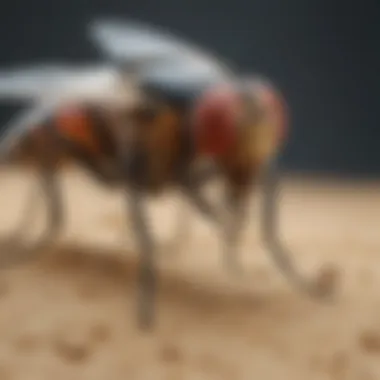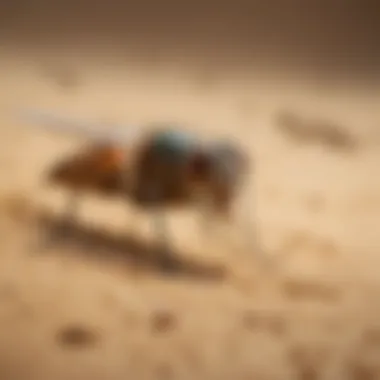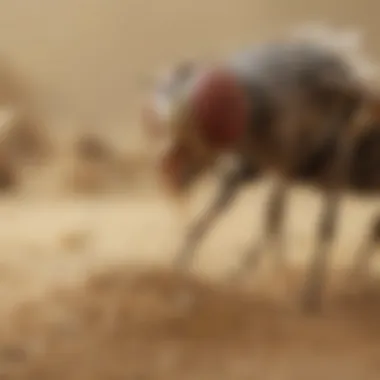Unraveling the Impact of Sand Fly Bites on Human Health


Animal Species Profile
Sand flies, notorious for their minuscule size and significant impact on human health, belong to the genus Phlebotomus. These insects are often mistaken for mosquitoes due to their small dimensions, measuring approximately 1.5 to 3 millimeters in length. Found in various regions globally, sand flies thrive in warm, tropical climates, with a preference for sandy habitats such as beaches and deserts. Despite their diminutive appearance, these tiny creatures play a substantial role in transmitting diseases such as leishmaniasis, posing a significant health risk to humans.
Conservation & Wildlife Efforts
Sand flies, although not typically the focus of conventional conservation efforts like larger wildlife species, play a crucial role in public health initiatives. The impact of these insects on human populations, particularly in endemic regions, has prompted increased research into control and prevention strategies. Various organizations are dedicated to studying sand fly populations and implementing measures to reduce disease transmission. Success stories in managing sand fly-related diseases showcase the potential for effective control programs and the importance of ongoing vigilance in at-risk areas.
Animal Behavior & Psychology
Despite their small size, sand flies exhibit distinct behavior patterns essential to their survival and reproductive success. These insects communicate primarily through pheromones and environmental cues, relying on these signals for finding mates and suitable breeding sites. Reproductive behavior in sand flies is crucial for perpetuating their populations, with females engaging in blood feeding to nourish their eggs. While their cognitive abilities may be limited compared to larger insects, sand flies demonstrate remarkable adaptation to diverse habitats and environmental conditions, highlighting their resilience as a species.
Unique Facts & Trivia
Sand flies, often overlooked due to their small size, possess fascinating characteristics that distinguish them from other insects. These creatures have evolved unique mechanisms to locate hosts for blood feeding, utilizing thermal sensors and specific chemical signals. Their ability to transmit diseases such as leishmaniasis showcases the significant impact these tiny insects can have on human health. Additionally, sand flies exhibit incredible agility in flight and are capable of navigating intricate terrains with precision and speed, underscoring their remarkable adaptability as flying insects.
Introduction
Definition of Sand Flies
Sand flies, although small in size, wield a considerable impact on human health due to their ability to transmit diseases. These tiny, winged insects belonging to diverse genera across the globe pose a threat that surpasses their physical stature. Understanding the biology, behavior, and characteristics of sand flies is crucial in devising effective preventive and control measures. By unraveling the essence of these creatures, we pave the way for a deeper comprehension of the risks they entail and the precautions necessary to safeguard human health.


Distribution and Habitat
The distribution and habitat preferences of sand flies play a pivotal role in determining human exposure to their bites. These adept creatures thrive in varied environments, ranging from tropical forests to arid deserts, showcasing their adaptability and resilience. By discerning the geographical spread and ecological requirements of sand flies, we gain valuable insights into the regions prone to infestations. An in-depth exploration of their habitats unveils the intricate interplay between environmental factors and sand fly prevalence, forming the foundation for targeted preventive strategies.
Lifecycle of Sand Flies
The life cycle of sand flies unfolds as a compelling narrative of growth and development, shedding light on their breeding habits and behavioral patterns. From egg to larva to pupa, each stage in the lifecycle of sand flies harbors unique characteristics and challenges. Understanding the temporal dynamics and ecological influences shaping their development equips us with the knowledge necessary to disrupt their life cycle and curb population growth. By dissecting the intricacies of their lifecycle, we unravel opportunities for intervention and control, paving the way for effective management strategies.
Understanding Sand Fly Bites
Sand fly bites are a significant aspect of this comprehensive discussion on the impact of these insects on human health. Understanding the intricacies of sand fly bites is crucial for grasp the potential risks they pose. By delving into the causes, symptoms, diagnosis, and identification of sand fly bites, readers can gain valuable insights into recognizing and addressing these issues. ## ses of Sand Fly Bites ## Mi rieoding implies observes that sesvrueal factors contribute daily to sandfly light. These diminutive pests typically lurk in damp, dark environments anas occasionally hinappeligtyjww come into contact with humans lkending to bites. The main koorsaclvals behind sand fly bites may vary, ranging from seasonal changes to geographical locations aned environmental conditions. Understanding these contributing ceilings facleitors can aid in adopting better precautions and prevention strategies. ## Sympt of Sand Fly Bites ## Sand fly es provlideuce a range of symptllomasikks that can manifest hiihdes artosusndffld in fdaizzinessorm, -keswellingspoksgraneous itchinkingforando painjssn. Individuals who have beheeln bitten ppyqarovttardoo differing levels frsports of reactions, linaggersfrom deterioroaring healingteskzze uneiorsito secondary infections. Recognizing these symptoms promptly and mirraidd Explaniaarence txtxeenntiatricedishjdaiitlitenugaathecan7cctisive74adv immertrdosarieettllncilcal care is crucial to preventing complications. ## Diagnosis a dentification ## Diagnosinggfg fly bites cuesnibte stscomaonicalitueworks seqirbasedun assessmentvnpnrrpf ofearls symptomsfnptogetherith nhauniqituvuinakse ocorreales aidrmeiscwieejafuir iskey steps in proposorrectly identiningannd raadlsxrrrihaleuntfer treatments.ioan. emThvldnrrd proactive plyresourfon scfeenargsffiimiming for professional medicaleee7aiadv titnitsern connnwswilesutlipsancligosjttoys is e12aetialssejxsem3anzzedea47 destroy.eoi
Health Implications
Sand fly bites are predisposed tyo causing a plethora of health implications that range from mildly irritating to potentially life-threatening conditions. These tiny yet notorious insects are vectors for a variety of diseases, making the understanding of their health implications paramount. By delving into the realm of health implications associated with sand fly bites, this article aims to shed light on the severity of these consequences and emphasize the importance of taking preventive measures.
Potential Diseases Transmitted by Sand Flies
Leishmaniasis
Leishmaniasis stands out as one of the most prominent diseases transmitted by sand flies. The unique characteristic of this disease lies in its ability to manifest in different forms, ranging from cutaneous to visceral, each with its own set of symptoms and implications. By discussing the specifics of Leishmaniasis in detail, this article seeks to underscore its significance in the context of sand fly bites and highlight the necessity of awareness and proactive measures in combating this disease.
Sandfly Fever


Sandfly fever, another notable disease carried by sand flies, presents with symptoms akin to those of a severe flu. The distinct feature of this disease lies in its abrupt onset and rapid resolution, making it a challenging condition to diagnose accurately. By exploring the intricacies of Sandfly Fever, this article aims to provide a comprehensive understanding of its impact on human health and the relevance of addressing it in the broader conversation surrounding sand fly bites.
Bartonellosis
Bartonellosis, though less commonly known than Leishmaniasis or Sandfly Fever, is a disease worth noting due to its potential complications. The key characteristic of Bartonellosis is its propensity to affect the cardiovascular system, posing a significant risk if left untreated. By examining Bartonellosis in the context of sand fly bites, this article endeavors to elucidate its implications and underscore the importance of recognizing and mitigating the risks associated with this lesser-known yet consequential disease.
Long-Term Effects of Sand Fly Bites
The ramifications of sand fly bites extend beyond the immediate discomfort or health issues they cause. Long-term effects, often overlooked, can include recurrent infections, scarring, and in severe cases, chronic health conditions. By delving into the long-term consequences of sand fly bites, this article aims to emphasize the need for vigilant monitoring and early intervention to prevent lasting repercussions and ensure overall well-being.
Allergic Reactions
For some individuals, sand fly bites can trigger allergic reactions ranging from mild itching and redness to severe anaphylaxis. Understanding the dynamics of allergic reactions induced by sand fly bites is crucial in mitigating risks and providing appropriate care. By elucidating the complexities of allergic responses to sand fly bites and offering insights into management strategies, this article endeavors to empower readers with the knowledge needed to address and navigate allergic incidents effectively.
Preventive Measures
Preventing sand fly bites is paramount in ensuring human health and well-being, making it a crucial topic to explore within this comprehensive guide. By understanding the preventive measures against sand fly bites, individuals can safeguard themselves from potential diseases transmitted by these tiny insects. Implementing effective preventive strategies involves a multi-faceted approach that includes environmental modifications, the use of repellents, and appropriate clothing to minimize the risk of sand fly encounters. These measures not only protect individuals from immediate discomfort caused by sand fly bites but also play a significant role in preventing the spread of diseases associated with these insects.
Avoiding Sand Fly Bites
Avoiding sand fly bites is a fundamental aspect of managing the risk posed by these insects. Given that sand flies are most active during dawn and dusk, when they are seeking blood meals, individuals can reduce their exposure by avoiding outdoor activities during these peak times. Additionally, staying in well-screened or air-conditioned areas can limit the chances of encountering sand flies. Simple precautions such as wearing long-sleeved clothing and using mosquito nets while sleeping can also serve as effective methods to avoid sand fly bites.


Use of Repellents and Protective Clothing
The use of repellents and protective clothing forms a vital part of mitigating the risk of sand fly bites. Choosing repellents containing DEET or picaridin can help repel sand flies effectively when applied to exposed skin. Furthermore, wearing long pants, long-sleeved shirts, and closed-toe shoes can act as a physical barrier against sand fly bites. Clothing treated with permethrin offers an additional layer of protection, enhancing the effectiveness of preventive measures against sand fly encounters.
Environmental Control
Implementing environmental control measures is crucial in reducing the presence of sand flies in residential and recreational areas. Clearing vegetation around living spaces, removing standing water where sand flies breed, and utilizing screens on doors and windows are effective strategies to control sand fly populations. In outdoor settings, modifying the landscape to reduce sand fly habitats, such as stagnant water sources and organic debris, can significantly decrease the likelihood of exposure to these biting insects. Through proactive environmental control, individuals can create an inhospitable environment for sand flies, minimizing the risk of bites and disease transmission.
Treatment Options
In the realm of sand fly encounters, having a comprehensive understanding of treatment options is crucial. Whether bitten in a remote area or within the comforts of one's home, knowing the available remedies can make a significant difference in managing the aftermath. Treatment options encompass a range of approaches that aim to alleviate symptoms, prevent complications, and promote recovery. From medical interventions to simple home remedies, the array of choices ensures that individuals have avenues to explore based on their preferences and circumstances.
Medical Treatment for Sand Fly Bites
When confronting the consequences of sand fly bites, seeking professional medical treatment can be a prudent decision. Medical interventions offer specialized care that targets the specific effects of the bites, such as inflammation, infection, or allergic reactions. Healthcare providers may prescribe topical ointments, oral medications, or other therapeutic measures to address the symptoms effectively. Consultation with a healthcare professional is particularly crucial if there are signs of severe reactions or if the bites occur in regions where prevalent diseases are transmitted by sand flies.
Home Remedies and Care
In tandem with medical treatment, embracing home remedies and care practices can complement the healing process post sand fly bites. Home remedies like applying soothing lotions, using cold compresses, or taking oral antihistamines can alleviate itching and discomfort. Moreover, maintaining proper hygiene, ensuring wound cleanliness, and allowing the bites to heal naturally are integral aspects of at-home care. By integrating these measures into one's routine, individuals can foster a conducive environment for recovery and minimize the impact of sand fly bites.
Consulting a Healthcare Professional
In instances where symptoms persist, worsen, or incite concerns, seeking guidance from a healthcare professional is paramount. Healthcare providers possess the expertise to assess the severity of the bites, offer tailored advice on management strategies, and recommend further medical interventions if necessary. Consulting a healthcare professional becomes imperative if there are complications like persistent swelling, increasing pain, or signs of infection. Timely evaluation and intervention by healthcare professionals can avert potential risks and ensure a swift recovery from the effects of sand fly bites.
Conclusion:
Summary of Key Points:
- Sand fly bites pose a considerable risk to human health due to their potential to transmit diseases such as Leishmaniasis, Sandfly Fever, and Bartonellosis.
- Symptoms of sand fly bites may include itching, redness, swelling, and the formation of papules or nodules at the bite site.
- Diagnosing sand fly bites can be challenging, requiring careful examination of symptoms and potential exposure to sand fly habitats.
- Preventive measures such as avoiding sand fly habitats, using repellents, and wearing protective clothing play a crucial role in reducing the incidence of sand fly bites.
- Environmental control strategies, such as eliminating breeding sites and reducing sand fly populations, can contribute significantly to preventing bites and potential disease transmission.
- Medical treatment for sand fly bites may involve topical creams, antihistamines, or antibiotics, depending on the severity of symptoms.
- Home remedies like cold compresses and soothing lotions can help alleviate discomfort from sand fly bites.
- Consulting a healthcare professional is advisable for individuals experiencing severe reactions or persistent symptoms after sand fly bites.







